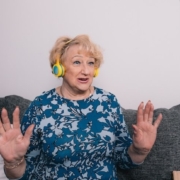Senior Living Social Media Marketing: Is It Time for TikTok?
Last month, we talked with Kerri-Anne Pendergast, our Director of Social Media Marketing, to discuss her approach when she works with our clients here at Senior Living SMART.
Today, we invited her back to address a burning question so many senior living communities have: Is it time to get on the TikTok bandwagon?
It’s an understandable question given how the platform exploded onto the scene in the U.S. in 2018 and rose to the be the most downloaded app in 2022, according to Statista. Further, TikTok boasted 755 million users in 2022 worldwide, 6.4% of which are 55 and older.
So, is TikTok worth all the hype? Like so many things in life, it depends. In this case, it depends on the audience you’re trying to reach. TikTok has made everything from beauty brands to authors “TikTok famous.” But what about senior living?
Let’s get Kerri-Anne’s take.
If you had to describe TikTok in a nutshell, what would you say?
TikTok is a fun social media platform that’s all about short-form videos. The audience is huge, but there are many niches, like BookTok, GamerTok, BusinessTok, etc.
What are some reasons why communities should consider TikTok?
It’s engaging, fun, and easy to go viral, thanks to TikTok’s algorithm (you don’t necessarily need to have a ton of followers or be a big brand to have a video take off).
Even better? This article from Insider discusses how participating in social media trends on TikTok might be good for seniors’ mental health. The same article points out that the reaction to TikToks featuring seniors has been overwhelmingly positive, too.
Over the last year or so, we’ve seen more senior living communities dipping their toes into TikTok. Here are some examples of popular TikToks featuring senior living residents.
@arcadiasrlivingbg Our halftime show > Rihanna’s halftime show 💃🪩🏈🤍🎶🎤 #seniorlivingcommunity #halftimeshow #SuperBowl #rihanna #fyp
@rivergroveresidents Pew Pew 😂😂❤️ #seniors #seniorliving #seniorcommunity #foryou #fypシ #nerf #rivergrove #nursinghome #residentsoftiktok #rehabfacility #activitiesdepartment #activitydirector #lovemyjob
♬ Mission Impossible Theme (Movie Trailer Mix) – Dominik Hauser
@nathanjoneslife Our visit with @ourseniormoments was so much fun. What is your favorite age so far? | #age #aging #seniorliving #grandmasoftiktok #interview
Why should communities hold off on TikTok, at least for now?
The two main reasons to hold off on TikTok:
- Your residents don’t want to participate. (Remember, you should always get explicit consent from the people appearing in your videos.)
- You don’t have someone in the community to create the videos. (There’s not much your marketing company can do to help with this. You need boots on the ground.)
In your opinion, what needs to happen for a community to develop a successful TikTok presence?
The recipe for success isn’t much different than it is for other social media platforms, with one exception—as we mentioned, TikTok is all about video, particularly short-form video. Only recently has TikTok allowed videos up to 10 minutes in length. Before, it was all about quick, entertaining vids in under 60 seconds (and these short videos are still hugely popular).
But getting back to best practices. If you want to create a successful TikTok presence for your senior living community, you must:
- Get consent and buy-in from residents appearing in your videos.
- Post regularly.
- Let the audience get to know your residents.
- Engage with the audience, answer their questions, and respond to their comments.
- Use trending music.
- Keep up with other popular trends.
- Have fun with it. (Because this WILL show in the final product.)
Do you think TikTok will become a must-have platform for senior living communities in the next five years?
In the near future, TikTok will continue to skew young. But that doesn’t mean you can’t maintain a presence for your senior living community, provided you have the interest and bandwidth.
TikTok will continue to be a great place for showing off your community’s lifestyle. But it won’t be the platform that helps you promote content or converts people into tours and move-ins. At least, not yet.
Facebook will likely remain the key social media platform for most senior living communities. Facebook is currently the number one social media platform in the U.S. and by a comfortable margin (74.2% of adults use it; the next platform after that is Instagram at 60.5%)
Of course, things will likely evolve over the next five to ten years, especially as younger Baby Boomers and Gen X near retirement age. So, like everything else, stay tuned.
If a senior living community had to focus on one or two social media platforms (TikTok, YouTube, Instagram, or Facebook), which ones do you recommend?
Focus on Facebook. It’s very well-rounded and fits the demographics better.
And here’s what you need to remember: TikTok isn’t the only place to consume short-form content. When TikTok took off, the other platforms took note. So today, Facebook and Instagram have Reels, and YouTube recently launched YouTube Shorts (videos that are sixty seconds or less).
In other words, people now have more options for consuming short-form content—they don’t need to go to TikTok. If you’ve already built a strong presence on Facebook and YouTube, try adding short videos to those platforms before starting a TikTok account.
Pro tip: If you create one short video, you can republish it in multiple places for expanded reach.
Is there anything else you want to ensure we convey about TikTok for senior living?
If you use it, post fun videos regularly and let the audience get to know your residents. Engage with the audience. If they have questions, do a TikTok that answers those questions. Respond to comments. And most importantly, have fun with it.
Go in with reasonable expectations. Remember, you won’t use it to promote content or schedule tours. Instead, you’ll use it to capture your community’s unique vibe. Keep it fun, light, and engaging.
Need fresh eyes on your social media marketing strategy?
We can help! Get in touch, and let’s discuss social media.





